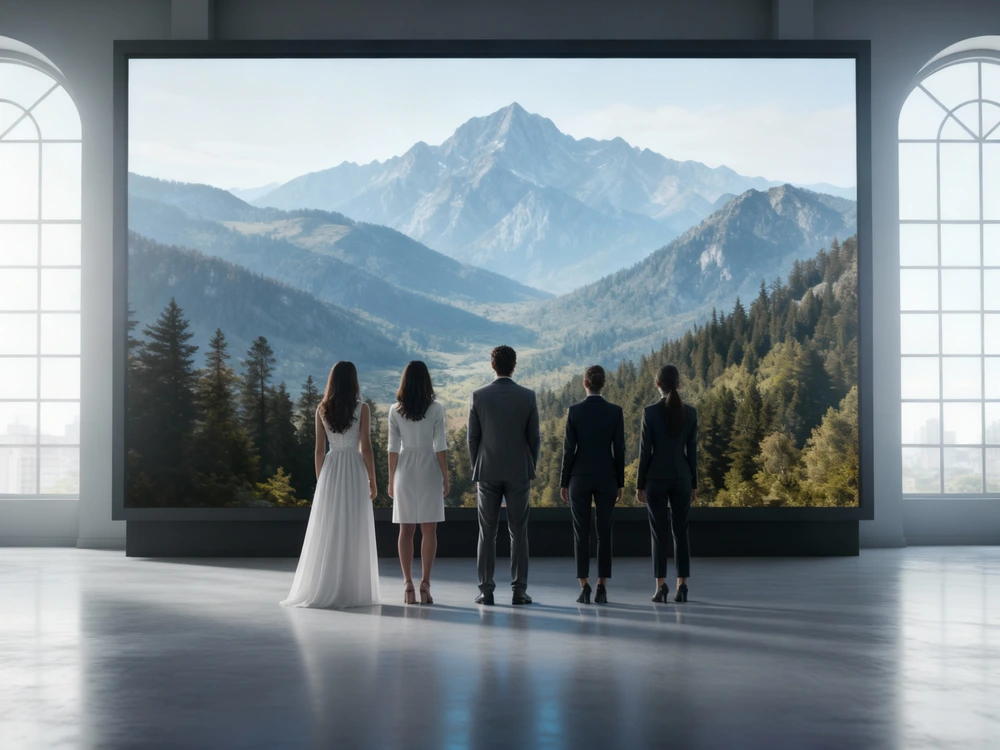Indoor vs. Outdoor LED Screen Displays: Key Differences & Best Applications
Introduction
LED screen displays have revolutionized the way businesses communicate with their audience, providing vibrant visuals, dynamic content, and high engagement levels. However, selecting the right LED display depends on where it will be used, the viewing distance, and environmental conditions.
The two primary categories of LED screens are indoor LED displays and outdoor LED displays. Each type has unique features and benefits, making them suitable for different applications. Whether you are considering an LED screen for a corporate event, advertising campaign, or public display, understanding the differences between indoor and outdoor LED screens will help you make an informed decision that aligns with your business needs.

Key Differences Between Indoor & Outdoor LED Screens
Both indoor and outdoor LED displays serve the purpose of delivering high-quality visual content, but they differ in brightness, durability, pixel pitch, and overall performance. Below are the primary distinctions:
1. Brightness Levels
Outdoor LED screens need to be much brighter than indoor screens to remain visible in broad daylight.
- Outdoor LED brightness: Typically ranges from 5,000 to 10,000+ nits to combat direct sunlight and ensure clear visibility.
- Indoor LED brightness: Usually ranges from 500 to 1,500 nits, as there is no direct sunlight interference inside buildings.
Example: A shopping mall may use an indoor LED display for promotional videos, while a highway billboard requires an outdoor LED screen with high brightness to be seen clearly during the day.

2. Weather Protection & Durability
Outdoor LED screens must withstand harsh weather conditions, including rain, dust, wind, and extreme temperatures. To ensure durability, these screens come with:
- Waterproof & Dustproof Ratings – Most outdoor LED displays are rated IP65 or higher, protecting them from rain and dust.
- Temperature Resistance – Designed to function in extreme heat or cold, making them suitable for all seasons.
On the other hand, indoor LED screens are not exposed to harsh elements, so they do not require waterproofing or heavy-duty enclosures. This makes them lighter, thinner, and more cost-effective than outdoor LEDs.
Example: An outdoor LED screen in a sports stadium needs to be waterproof to function during rainy weather, whereas an LED screen in a conference room only requires a standard enclosure.
3. Pixel Pitch & Viewing Distance
Pixel pitch determines the clarity and resolution of an LED display. The smaller the pixel pitch, the better the screen resolution for close-up viewing.
- Indoor LED screens have smaller pixel pitches (P1.5 – P4) to provide sharp, high-resolution images when viewed from short distances.
- Outdoor LED screens have larger pixel pitches (P5 – P16) because they are meant to be viewed from long distances.
Example: An indoor LED video wall in a theater needs a fine pixel pitch to ensure crisp images, while an outdoor LED billboard can use a larger pixel pitch, as viewers are farther away.
Best Applications for Indoor & Outdoor LED Displays
Indoor LED Displays – Ideal for Controlled Environments
Indoor LED screens are commonly used in businesses, educational institutions, and entertainment venues to provide engaging visual content. Some of the best applications include:

- Conference Rooms – Used for presentations, video conferencing, and data visualization.
- Retail Stores – Showcasing advertisements, promotions, and digital menus.
- Theaters & Event Halls – Creating immersive entertainment experiences.
- Shopping Malls – Digital directional signage and promotional ads.
Example: A luxury clothing brand may use an LED video wall inside its flagship store to showcase fashion campaigns and brand messaging in high definition.
Outdoor LED Displays – Perfect for Large-Scale Advertising
Outdoor LED screens are designed to be highly visible and weather-resistant, making them the go-to choice for public advertising and event coverage. Some of the best applications include:
- Billboards & Digital Advertising Boards – For brand promotions and marketing campaigns.
- Stadium Screens – Displaying sports scores, replays, and advertisements.
- Public Events & Concerts – Streaming live performances to large audiences.
- Transportation Hubs – Digital signboards at airports, bus terminals, and train stations.
Example: A fast-food chain can use outdoor LED billboards on highways to advertise limited-time offers, ensuring visibility to thousands of commuters daily.
Conclusion
When selecting between indoor and outdoor LED screen displays, consider factors such as brightness, weather resistance, pixel pitch, and viewing distance.
- If you need a display for a retail store, conference hall, or shopping mall, an indoor LED screen with high resolution and lower brightness is the best choice.
- If you need a display for outdoor advertising, stadiums, or large-scale public events, an outdoor LED screen with high brightness and weatherproof protection is the ideal solution.
By understanding these key differences, businesses can invest in the right LED technology that enhances their visibility, engagement, and overall marketing impact.
If you’re considering upgrading to LED displays, evaluate your specific business needs and environmental conditions before making a decision. Investing in the right LED screen display will maximize your return on investment and boost your brand presence in the long run.



